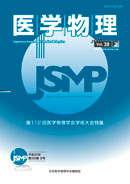Volume 38, Issue 2
Displaying 1-19 of 19 articles from this issue
- |<
- <
- 1
- >
- >|
PREFATORY NOTE
-
2018Volume 38Issue 2 Pages 47
Published: October 31, 2018
Released on J-STAGE: November 01, 2018
Download PDF (148K)
TECHNICAL NOTE
-
2018Volume 38Issue 2 Pages 48-57
Published: October 31, 2018
Released on J-STAGE: November 01, 2018
Download PDF (1336K)
⟨Special Issue: The 112th Scientific Meetings of the Japan Society of Medical Physics⟩
REVIEWS
-
Article type: Special Issue: The 112th Scientific Meetings of the Japan Society of Medical Physics Symposium 1
2018Volume 38Issue 2 Pages 58-61
Published: October 31, 2018
Released on J-STAGE: November 01, 2018
Download PDF (622K) -
Article type: Special Issue: The 112th Scientific Meetings of the Japan Society of Medical Physics Symposium 1
2018Volume 38Issue 2 Pages 62-67
Published: October 31, 2018
Released on J-STAGE: November 01, 2018
Download PDF (851K) -
Article type: Special Issue: The 112th Scientific Meetings of the Japan Society of Medical Physics Symposium 1
2018Volume 38Issue 2 Pages 68-73
Published: October 31, 2018
Released on J-STAGE: November 01, 2018
Download PDF (742K) -
Article type: Special Issue: The 112th Scientific Meetings of the Japan Society of Medical Physics Symposium 2
2018Volume 38Issue 2 Pages 74-78
Published: October 31, 2018
Released on J-STAGE: November 01, 2018
Download PDF (1039K) -
Article type: Special Issue: The 112th Scientific Meetings of the Japan Society of Medical Physics Symposium 2
2018Volume 38Issue 2 Pages 79-84
Published: October 31, 2018
Released on J-STAGE: November 01, 2018
Download PDF (785K) -
Article type: Special Issue: The 112th Scientific Meetings of the Japan Society of Medical Physics Symposium 2
2018Volume 38Issue 2 Pages 85-88
Published: October 31, 2018
Released on J-STAGE: November 01, 2018
Download PDF (514K) -
Article type: Special Issue: The 112th Scientific Meetings of the Japan Society of Medical Physics International Session
2018Volume 38Issue 2 Pages 89-92
Published: October 31, 2018
Released on J-STAGE: November 01, 2018
Download PDF (143K) -
Article type: Special Issue: The 112th Scientific Meetings of the Japan Society of Medical Physics International Session
2018Volume 38Issue 2 Pages 93-95
Published: October 31, 2018
Released on J-STAGE: November 01, 2018
Download PDF (206K)
⟨Special Issue Series: RPT⟩
-
Article type: Special Issue Series: RPT
2018Volume 38Issue 2 Pages 96
Published: October 31, 2018
Released on J-STAGE: November 01, 2018
Download PDF (102K)
ARTICLE REVIEWS
-
Article type: Special Issue Series: RPT RPT Doi Award
2018Volume 38Issue 2 Pages 97
Published: October 31, 2018
Released on J-STAGE: November 01, 2018
Download PDF (250K) -
Article type: Special Issue Series: RPT RPT Doi Award
2018Volume 38Issue 2 Pages 98
Published: October 31, 2018
Released on J-STAGE: November 01, 2018
Download PDF (276K) -
Article type: Special Issue Series: RPT RPT Doi Award
2018Volume 38Issue 2 Pages 99
Published: October 31, 2018
Released on J-STAGE: November 01, 2018
Download PDF (215K)
REPORT OF JSMP MEETING
-
2018Volume 38Issue 2 Pages 100-105
Published: October 31, 2018
Released on J-STAGE: November 01, 2018
Download PDF (991K)
REPORT OF INTERNATIONAL CONFERENCE
-
2018Volume 38Issue 2 Pages 106-107
Published: October 31, 2018
Released on J-STAGE: November 01, 2018
Download PDF (603K)
INTRODUCTION OF RESEARCH FACILITY
-
2018Volume 38Issue 2 Pages 108-110
Published: October 31, 2018
Released on J-STAGE: November 01, 2018
Download PDF (1304K)
BOOK REVIEW
-
2018Volume 38Issue 2 Pages 111
Published: October 31, 2018
Released on J-STAGE: November 01, 2018
Download PDF (198K)
EDITOR'S NOTE
-
2018Volume 38Issue 2 Pages 112
Published: October 31, 2018
Released on J-STAGE: November 01, 2018
Download PDF (183K)
- |<
- <
- 1
- >
- >|
